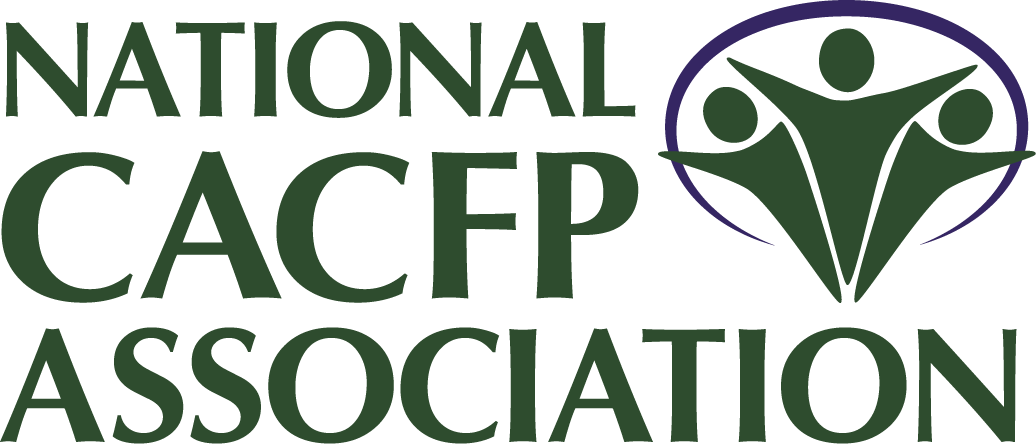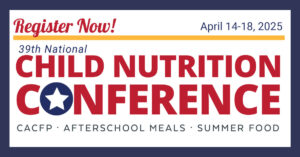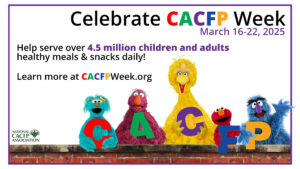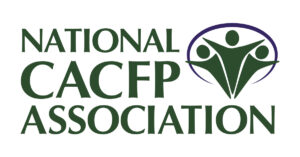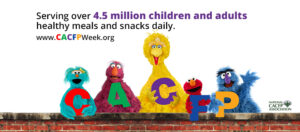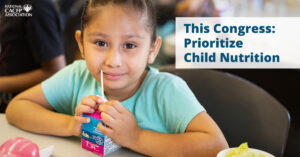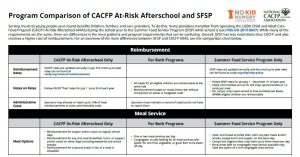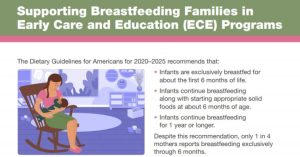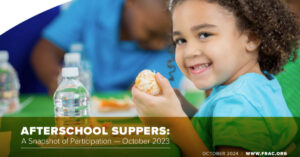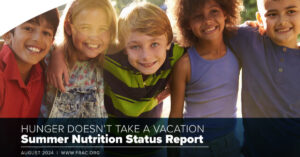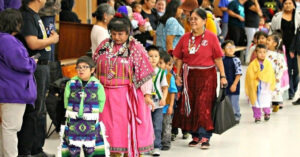Fifteen scholarship opportunities will be available from the National CACFP Sponsors Association (NCA) for the 2023 National Child Nutrition Conference. Learn more here.
Read MoreWe rounded up the delicious recipe recommendations from our Giving Thanks: Turkey Talk & More webinar into one spot to help you piece together a perfect meal that includes all the required meal components.
Read MoreYou asked, and we are here to answer: are turkey sausage and turkey bacon creditable in the CACFP?
Read MoreUse this silly relay race game and extension activities to teach children about postal workers, some of our favorite community helpers!
Read MoreWe want you to be empowered to turn any healthy recipe into a creditable one. Join us on Thursday, December 15, 2:00 pm to 3:00 pm Eastern for How to Credit Recipes in the CACFP.
Read MoreInspired by NCNC25 Keynote Speaker Mike Brown, Jr.
The National Child Nutrition Conference is more than just a training opportunity, it’s a chance for our community to come together, connect and get inspired. This year, we are thrilled to announce our keynote speaker, Mike Brown, Jr., MS, CFRE, President and CEO of the YMCA of Metropolitan Fort Worth.
Read MoreCheck out these virtual events coming up this month at NCA!
Read MoreThe National CACFP Association proudly announces the upcoming 39th annual National Child Nutrition Conference (NCNC), set to take place both in-person at The Anatole Dallas and virtually online. The event will bring together over 2,100 passionate individuals from organizations across the country including child care centers, home providers, sponsoring organizations, school districts, afterschool programs, Head Start programs, Food Banks, tribal nations, and State Agencies.
Read MoreNCA would like to congratulate the 2025 recipients!
Read MoreCheck out these virtual events coming up this month at NCA!
Read MoreHere are seven ways for you to celebrate with the CACFP community.
Read MoreOn January 27, President Trump’s office issued a memorandum based on his executive orders which calls for temporarily pausing federal funding. This has caused concern to many programs and people, including those in our community.
Read MoreNational CACFP Week will be here before you know it! This year March 16-22 marks this national education campaign designed to raise awareness of the CACFP and its contribution to combating hunger. Ask Your Governor to Proclaim March 16-22, 2025 as National CACFP Week!
Read MoreThe end of 2024 brought many changes and updates for the CACFP. USDA announced funding for child care to purchase local, released two requests for information, released seven pieces of guidance, published two studies.
Read MoreA new congress means there is an opportunity to push new priorities forward. Let your Representatives and Senators know that child nutrition is a priority for their constituents.
Read MoreThe USDA has released the SFSP reimbursement rates for 2025.
Read MoreThis memo is the third set of questions and answers on the rural non-congregate summer meals option. The following operational topics are addressed in this guidance: Meal Service and Meal Quality; Civil Rights Requirements; Monitoring and Program Integrity; and General/Miscellaneous.
Read MoreThe Child and Adult Care Food Program has new creditable foods listed on the USDA Food Buying Guide! If you are new to the FBG, this interactive tool allows for easy display, search, and navigation of food yield information. In addition, users can compare yield information, create a favorite foods list, and access tools, such as the Recipe Analysis Workbook (RAW) and the Product Formulation Statement Workbook.
Read MoreThe Child and Adult Care Food Program community asked for more Spanish resources to be available on the National CACFP Sponsors Association website and we heard you! Available now in Spanish are more resources to help sponsors and providers with meal pattern requirements, best practices, and so much more!
Read MoreServing meals to young people year-round benefits children, families, and care providers. To do this, many providers transition from operating the USDA Child and Adult Care Food Program (CACFP) At-Risk Afterschool (ARAS) during the school year to the Summer Food Service Program (SFSP) while school is out. For an overview of the main differences between SFSP and CACFP ARAS, see the comparison chart below.
Read MoreNCA understands that the end of flexibilities will cause challenges for many CACFP sponsors and providers and we commend your continued commitment to providing nutritious meals and snacks to the children or adults in your care. In preparation for the end of the additional reimbursement, we have collected the following resources to help you successfully provide meals even if your available budget decreases.
Read MoreCDC created three new fact sheets for Early Care and Education (ECE) providers about Early Child Nutrition and Feeding. The fact sheets offer tips and best practices for supporting breastfeeding families, information about safe storage and handling of breastmilk, and strategies for introducing solid foods.
Read MoreIs a medical statement needed for meal modifications due to disability reasons?
Read MoreAre there updated sugar limits for breakfast cereals in the CACFP?
Read MoreAre there updated sugar limits for yogurt in the CACFP?
Read MoreCan a milk and fruit smoothie be served as the only item at snack?
Read MoreAre quick breads considered grain-based desserts?
Read MoreIn family style meal service, are meals consumed by supervising adults reimbursable in the CACFP?
Read MoreThe Child and Adult Care Food Program has new creditable foods listed on the USDA Food Buying Guide! If you are new to the FBG, this interactive tool allows for easy display, search, and navigation of food yield information. In addition, users can compare yield information, create a favorite foods list, and access tools, such as the Recipe Analysis Workbook (RAW) and the Product Formulation Statement Workbook.
Read MoreThe Child and Adult Care Food Program community asked for more Spanish resources to be available on the National CACFP Sponsors Association website and we heard you! Available now in Spanish are more resources to help sponsors and providers with meal pattern requirements, best practices, and so much more!
Read MoreServing meals to young people year-round benefits children, families, and care providers. To do this, many providers transition from operating the USDA Child and Adult Care Food Program (CACFP) At-Risk Afterschool (ARAS) during the school year to the Summer Food Service Program (SFSP) while school is out. For an overview of the main differences between SFSP and CACFP ARAS, see the comparison chart below.
Read MoreNCA understands that the end of flexibilities will cause challenges for many CACFP sponsors and providers and we commend your continued commitment to providing nutritious meals and snacks to the children or adults in your care. In preparation for the end of the additional reimbursement, we have collected the following resources to help you successfully provide meals even if your available budget decreases.
Read MoreCDC created three new fact sheets for Early Care and Education (ECE) providers about Early Child Nutrition and Feeding. The fact sheets offer tips and best practices for supporting breastfeeding families, information about safe storage and handling of breastmilk, and strategies for introducing solid foods.
Read MoreThe “Characteristics of Emergency Shelters Participating in the CACFP” study by USDA seeks to better understand the characteristics of CACFP emergency shelters, who they serve, how CACFP fits into their operations, and their challenges with CACFP. The study was conducted in 2023 and collected data from 242 emergency shelters that participate in CACFP in Fiscal Year 2023.
Read MoreA survey was administered in the spring of 2023 of licensed California family child care homes (FCCH) to assess the perceived impacts of the increased reimbursement during the Covid-19 pandemic on CACFP participation and anticipated challenges with reinstated tiered rates.
Read MoreThe USDA recently released a study on the “Characteristics of Adult Day Care Centers that Participate in the USDA’s Child and Adult Care Food Program” which seeks to better understand key characteristics of adult day care centers participating in CACFP.
Read MoreUSDA released a survey report focused on SFSP and SSO sponsors who operated the non-congregate meal service option in qualifying rural areas in summer 2023.
Read MoreAfterschool Snack Programs include the National School Lunch Program (NSLP) and the Child and Adult Care Food Program (CACFP). Through NSLP schools can serve one snack afterschool, however through the CACFP schools and sponsoring organizations are able to serve a snack in addition to a supper. This additional supper is an important opportunity to meet children’s nutritional needs after the school day is over. A report by the Food Research and Action Center (FRAC) found that afterschool supper participation increased from October 2022 to October 2023 by 6%.
Read MoreFRAC’s latest report, Hunger Doesn’t Take a Vacation: Summer Nutrition Status Report 2024, reveals a drop in the number of children receiving nutrition over the summer following the loss of pandemic-era waivers.
Read More